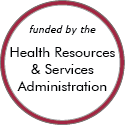Rural Project Examples: Health workforce
Other Project Examples
Rural Firefighters Delivering Agricultural Safety and Health (RF-DASH)
Updated/reviewed October 2025
- Need: To reduce injuries in agricultural communities and improve emergency responders' preparedness when called to farms and ranches.
- Intervention: RF-DASH equips rural fire/EMS personnel and others with agricultural health and safety knowledge and tools to pre-plan for agricultural emergencies as well as assess and then mitigate agricultural hazards.
- Results: Over 250 firefighters and EMTs have received training to become RF-DASH trainers.
Implementation of a Nursing Veterans' Initiative to Transform Education (INVITE)

Updated/reviewed September 2025
- Need: To support rural veterans pursuing a career in nursing.
- Intervention: The INVITE program improved the curriculum and reworked admission requirements to better support veteran students' experiences in the College of St. Scholastica undergraduate nursing program.
- Results: The number of veterans pursuing nursing has more than doubled since program implementation, and all students have reported an increased interest in serving rural communities.
McPherson Hospital High School Internship Program
Added September 2025
- Need: To provide high school students with hands-on health care experience while filling high-need roles in a rural hospital.
- Intervention: An internship program for high school students at McPherson Center for Health in McPherson, Kansas.
- Results: More than 30 students have participated in the program since 2023, seven of whom have become part-time or full-time employees at the hospital as a result.
Military Medics and Corpsmen Program
Updated/reviewed September 2025
- Need: To help veterans transition into civilian healthcare careers.
- Intervention: MMAC and healthcare employers in urban and rural Virginia provide employment and education opportunities to veterans seeking civilian medical credentials.
- Results: MMAC has been able to help 837 veterans, transitioning service members, and military spouses find healthcare employment.
Project PROMISE
Updated/reviewed September 2025
- Need: An increased interest among young people to pursue a medical career in rural North Carolina
- Intervention: Two medical students started a program that gives high school seniors medical academic training, mentor relationships, and hands-on experience in rural North Carolina facilities.
- Results: Project PROMISE has 40 high school completers, 19 of whom are pursuing an undergraduate degree with an interest in studying medicine. Two students are currently in medical school, with plans to work in a rural area once finished.
CAPABLE (Community Aging in Place—Advancing Better Living for Elders)
Updated/reviewed July 2025
- Need: To help older adults age in place.
- Intervention: For four to five months, CAPABLE participants receive home visits from a registered nurse, occupational therapist, and home repair services.
- Results: There are currently 38 CAPABLE sites across the country, 19 of which are located in rural communities.
The Massachusetts Department of Public Health TeleSANE Center
Updated/reviewed July 2025
- Need: Clinicians in rural and underserved areas are often unprepared to provide comprehensive medical-forensic examinations for patients who present for care following a sexual assault.
- Intervention: The MDPH TeleSANE Center uses secure telehealth software to connect sexual assault nurse examiners to clinicians and patients in hospitals across Massachusetts — including five in rural counties — offering expert clinical guidance and support before, during, and after examinations.
- Results: Clinicians report that the service gives them increased confidence throughout the examination process. To date, the MDPH TeleSANE Center has assisted in the care of over 1,234 patients.
Structured Training for Rural Enhancement of Community Health in Obstetrics (STRETCH-OB)

Updated/reviewed June 2025
- Need: To improve maternal and birth outcomes in rural and underserved areas by increasing the number of family medicine physicians in these areas who have high-quality, evidence-based obstetrical care skills.
- Intervention: The STRETCH-OB program trains a select number of family medicine residents at the University of Illinois College of Medicine Rockford each year to provide high-quality maternity care, including surgical obstetrical care.
- Results: Four STRETCH-OB residents have graduated as of June 2025 and all have cesarean section privileges in their practice.
Auburn University Rural Health Initiative
Updated/reviewed May 2025
- Need: To expand healthcare access in rural Alabama communities.
- Intervention: The Auburn University Rural Health Initiative is working with communities across Alabama to develop a healthcare model that includes primary care, substance use disorder treatment and mental health treatment via state-of-the-art telehealth technologies, coupled with health and wellness programs and services provided by faculty and students.
- Results: As of 2025, there are five telehealth care stations open located in LaFayette, Boligee, Akron, Catherine, and Gainesville, Alabama. These stations have impacted over 3,400 individuals, with 187 community events, 1207 patient consultations, and 43 new health ambassadors.
Queen Anne's County Mobile Integrated Community Health (MICH) Program
Updated/reviewed May 2025
- Need: To connect patients to resources in order to reduce use of emergency services, emergency department visits, and hospital readmissions.
- Intervention: Patients receive support (by in-person visit, phone call, or telehealth visit) from a paramedic, community health nurse, peer recovery specialist, and pharmacist.
- Results: Between July 2016 and March 2024, the program made 1,098 patient contacts and continued to see a reduction in emergency department and inpatient visits and costs.
For examples from other sources, see:
